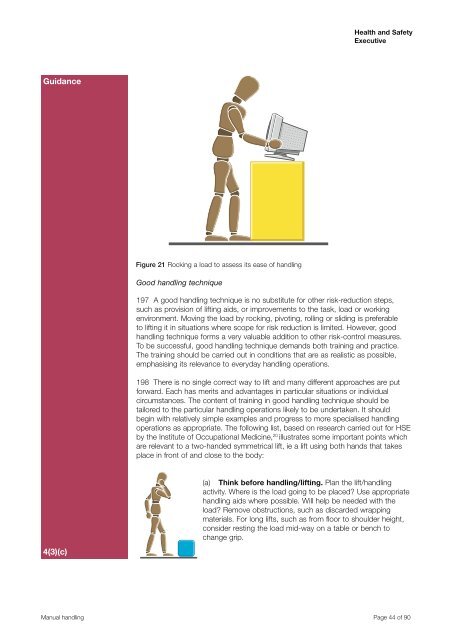Manual Handling Manual Handling Operations Regulations 1992 ...
Manual Handling Manual Handling Operations Regulations 1992 ...
Manual Handling Manual Handling Operations Regulations 1992 ...
Create successful ePaper yourself
Turn your PDF publications into a flip-book with our unique Google optimized e-Paper software.
Health and Safety<br />
Executive<br />
Guidance<br />
Figure 21 Rocking a load to assess its ease of handling<br />
Good handling technique<br />
197 A good handling technique is no substitute for other risk-reduction steps,<br />
such as provision of lifting aids, or improvements to the task, load or working<br />
environment. Moving the load by rocking, pivoting, rolling or sliding is preferable<br />
to lifting it in situations where scope for risk reduction is limited. However, good<br />
handling technique forms a very valuable addition to other risk-control measures.<br />
To be successful, good handling technique demands both training and practice.<br />
The training should be carried out in conditions that are as realistic as possible,<br />
emphasising its relevance to everyday handling operations.<br />
198 There is no single correct way to lift and many different approaches are put<br />
forward. Each has merits and advantages in particular situations or individual<br />
circumstances. The content of training in good handling technique should be<br />
tailored to the particular handling operations likely to be undertaken. It should<br />
begin with relatively simple examples and progress to more specialised handling<br />
operations as appropriate. The following list, based on research carried out for HSE<br />
by the Institute of Occupational Medicine, 20 illustrates some important points which<br />
are relevant to a two-handed symmetrical lift, ie a lift using both hands that takes<br />
place in front of and close to the body:<br />
4(3)(c)<br />
(a) Think before handling/lifting. Plan the lift/handling<br />
activity. Where is the load going to be placed? Use appropriate<br />
handling aids where possible. Will help be needed with the<br />
load? Remove obstructions, such as discarded wrapping<br />
materials. For long lifts, such as from floor to shoulder height,<br />
consider resting the load mid-way on a table or bench to<br />
change grip.<br />
<strong>Manual</strong> handling Page 44 of 90
















